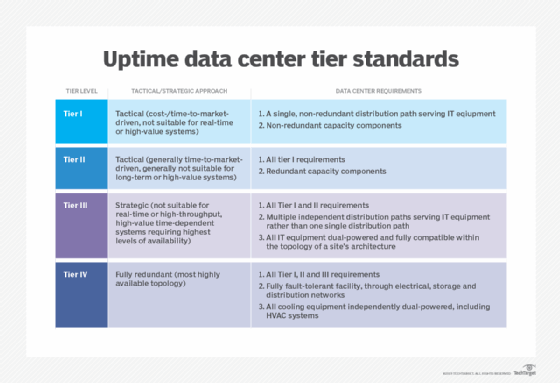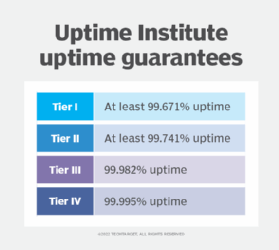What are the Uptime Institute's data center tier standards?
Data center tiers are a system created by Uptime Institute LLC to describe the availability of infrastructure resources in a facility. A division of 451 Group, the Uptime Institute is the standard for this certification effort, which defines what is required to ensure that data centers meet an organization's business demands. The tiering system came into place in the mid-1990s, making choosing a data center design and construction, whether it be public or private, a lot easier when it comes to predicted uptime and availability.
There are four tiers, ranked by Roman numerals from Tier I -- the most basic data center design meeting the Institute's core requirements -- to Tier IV -- the most fault-tolerant and available data center design. Note that only Roman lettering is allowed; any data center advertising itself with Arabic numerals -- Tier 3, for example -- should be reviewed as it might not be certified by the Uptime Institute.
As the tier levels increase, organizations must make bigger investments to meet certification criteria. Organizations should prepare a risk assessment that balances business risk against cost and use this to decide which tier is right for them. The Uptime Institute has its own professional services group that can help organizations prepare such assessments and then provide help to design the facility.
What are the factors considered for data center tier classification?
The Uptime Institute assesses a data center facility or its design documents before allowing any organization to claim a tier classification. Tier Certification of Design Documents checks an organization's design documents against the Uptime Institute's criteria and then awards a tier classification based on that information.
Tier Certification of Constructed Facility then ensures the facility has been built accurately against the design documents. Finally, Tier Certification of Operational Sustainability (TCOS) measures the capability of a facility to operate and meet expected availability and efficiency levels. All facilities with a data center tier classification are then listed on the Uptime Institute's website. There are currently more than 1,700 certifications across 98 countries.
Tier classifications focus mainly on platform availability. Areas of consideration include the following:
- Power. What level of power redundancy is in place, not just within the data center, but from the grid to the facility?
- Cooling. Does the facility have enough cooling to meet the needs of critical areas of the platform? Is this cooling matched with redundancy? Is there any room for overhead?
- Maintenance. Can the environment be maintained as planned and without significant, or any, downtime?
- Fault management capabilities. Is the entire platform capable of surviving the failure of one or more components without affecting IT systems?
What are the different data center tiers?
The Uptime Institute tiers are defined as follows.
Tier I (basic capacity). Tier I facilities protect against much of the human error involved in running data center operations, but they aren't resilient to unexpected outages or equipment failure. Preventive maintenance and repairs generally require a complete shutdown of the IT capability. Lack of adequate planning to deal with maintenance on a regular basis could result in extended and costly platform downtime. Tier I includes the following components:
- Uninterruptible power supply (UPS) to survive basic power outages, power sags and power spikes.
- Dedicated area for IT systems.
- Dedicated cooling systems that operate 24/7.
- Diesel or gas generators to cover longer power outages than the UPS can manage.
Tier II (redundant capacity). This classification builds on Tier I by adding more power resiliency through the following features:
- Engine generators, including fuel tanks to hold enough fuel to keep generators running for a longer period.
- Energy storage that enables the organization to switch from grid power services to engine power generation.
- Dedicated chillers or other cooling units, rather than simple air conditioning units.
- Heat rejection equipment that enables heat to be removed more effectively than with simple air conditioning.
Tier III (concurrently maintainable). The third tier builds on Tier II capabilities to provide enhanced platform availability, including these elements:
- Concurrent maintainability through the use of redundant components.
- Use of redundant power distribution paths.
Tier IV (fault-tolerant). These facilities provide the ultimate in platform resiliency by building on the previous tiers through the addition of multiple independent and isolated systems that provide redundant capacity and power distribution.
How do the different tiers compare?
Tier I data centers provide a competent environment with basic protection against systems failure and a degree of redundancy to manage power outages. However, these facilities don't have resilience when it comes to equipment failure.
Tier II facilities provide much greater protection against power outages through generation redundancies, as well as enhanced storage of fuel and possibly energy.
Tier III facilities offer concurrent maintainability; this means the facility doesn't have to shut down to replace key equipment, as there is enough equipment redundancy to enable planned and unplanned maintenance.
Tier IV facilities provide the ultimate in fault tolerance: Everything is dual-powered; redundant electrical, distribution and storage systems are available; and highly redundant server and network architectures are in place. Tier IV facilities should survive any failure, provided there is enough fuel to fill the facility's generators and areas outside the data center owner's control, such as public networks, are available.

Choosing the right data center tier
Many small and medium-sized businesses that have outgrown an office-based IT system -- a few servers and a simple PC/laptop network, for example -- find that a move to a Tier II, Tier III or Tier IV facility is expensive. A Tier I facility, which can be created by converting existing space within many office environments, is often enough in these situations.
For those organizations where downtime is more of an issue and where power outages are relatively common, a Tier II facility makes more sense, as it builds in more power fault tolerance.
When the availability of the overall IT platform is more of an issue, Tier III offers systems redundancy with a strong capability to maintain a high-availability platform.

Tier IV is for organizations where availability is non-negotiable -- for example, high-throughput financial systems or national security systems. While costly, this tier is a good investment, as equipment should always be available. However, Tier IV is based on single overall redundancy at all points, so the failure of one piece of equipment can become an opportunity for systems failure should a second item fail while the first is being replaced.
To get around this issue, the Uptime Institute offers further certification levels using bronze, silver and gold TCOS levels. These levels recognize how facility owners have gone beyond the basic tier classifications -- for example, by adding three-way redundancy to their platforms.
Data center owners who don't believe they can easily move the existing facility toward a tier-certified facility can take advantage of the Uptime Institute's professional services to see what would be required. The Institute also offers a separate service that performs an operational assessment that can lead to a Management & Operations Stamp of Approval rating.
Alternatives to the Uptime Institute
The Uptime Institute's primary focal points in its tier standards are power systems, data center cooling, and environment management and system availability. The standards have been popular for many years, owing largely to their simplicity and ease of understanding. That said, several alternatives have emerged in recent years that should be carefully examined, perhaps not to replace Uptime Institute standards but to identify additional criteria that can increase a data center's ability to perform.
The following are current alternatives to the Uptime Institute's four tiers.
ANSI/TIA-942 Telecommunications Infrastructure Standard for Data Centers. Originally developed as a cabling standard by the Telecommunications Industry Association (TIA), TIA-942 today addresses a broad range of data center attributes. It is recognized as an official American National Standards Institute (ANSI) standard, and its various elements offer important guidance when designing a new data center or preparing to upgrade one.
ANSI/BICSI 002-2019 Data Center Design and Implementation Best Practices. Often considered the most widely recognized data center design guideline, 002-2019 addresses the essential issues associated with data center design, from initial design and planning to commissioning. It includes design standards from other organizations, such as TIA and the International Organization for Standardization.
ISO 22237:2021 Information technology -- Data centre facilities and infrastructures. Developed by the ISO, this standard provides a foundation for the design of data centers. It includes a classification system for data center criteria, plus descriptions of data center components and operational characteristics.
Tier 5 Platinum standard from Switch Inc. Developed to raise the bar over the Uptime Institute's four tiers, Tier 5 (not Roman numeral V) data centers exceed Tier IV criteria with the addition of components including enhanced power systems, multiple telecom carriers and power suppliers, positioning of cooling lines within the center, enhanced physical and network infrastructure security, and the use of fully renewable energy sources. The goal is a fully fault-tolerant data center and associated infrastructure. Switch also provides high-performance exascale data center ecosystems in several U.S. locations.
The Green Grid data center standards. Founded in 2007 to support the development of efficient data centers, The Green Grid was acquired by the Information Technology Industry Council in 2019. It offers the following tools to use when designing or updating data centers:
- TggCDU, a coolant distribution unit sizing tool.
- TggGPI, a performance indicator tool for assessing data center cooling.
- TggTCO, a total cost of operations calculator for cooling systems.
- TggWUI, a water usage impact calculation tool.
The organization also provides the following resources for data center operators and developers:
- Data Center Resource Effectiveness (DCRE). DCRE is a set of metrics and a tool for examining multiple factors associated with data centers to ensure the center is energy efficient and environmentally friendly.
- Open Standard for Data Center Availability (OSDA). Launched in 2016 to set a data center availability and rating system for energy-efficient and sustainable data center designs, OSDA is available as a document and online tool.
Pros and cons of Uptime Institute certification
Considering the ubiquity and acceptance of the Uptime Institute's tier standards, there are many reasons to obtain certification, including the Institute's reputation and credibility, getting certified to a recognized standard, ongoing identification of potential risks, support for continuous improvement and the prestige associated with an Uptime Institute certification.
Conversely, the downsides of certification might include the costs and time needed to achieve certification, dealing with a complex certification process, and a limited scope of certification criteria -- e.g., uptime and reliability -- as compared to other standards that also address energy efficiency and sustainability.
Data center tiers effectively categorize different types of facilities, but it is essential to recognize the ranking system's limitations. This understanding ensures informed decisions and optimal facility management. Learn more about the pros and cons of data center tiers.







